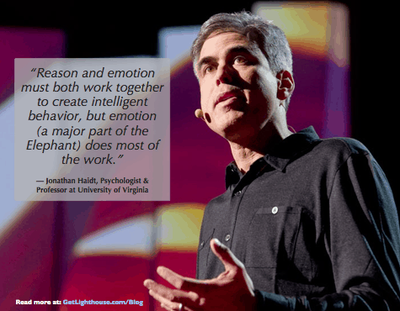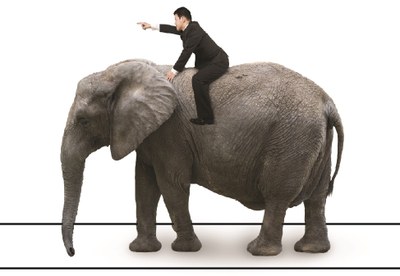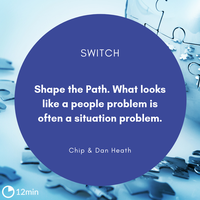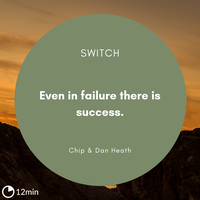How Good are You at Changing Behavior?
Have you ever slept in and gotten angry? Maybe something you regretted or started drinking soda after declaring you would only drink water at lunch? If so, you have experienced the tension that exists between your mind and your heart; your rational side and your emotional side. The rational mind plans for the long-term and “knows” that it is best if to get out of bed and exercise before you go to work, to keep your cool and not get angry in a meeting, or to drink more water. Nevertheless, the emotional heart resists these rational plans and tends toward the quick fix; the immediate comfort of giving in. This tension between your rational mind and your emotional heart resides within all of us. Making behavior change is hard for you, your family members, your community, and the people you work with. This tension between our rational mind and emotional heart is why all change is hard, whether at the individual or organizational level.
What can we do to effect change? As leaders in our family, at work, and in our community organizations, we are called to lead change efforts when change is needed. How do we deal with this mind vs. heart tension? Fortunate for us, we can look for guidance in a book published in 2010 by Chip and Dan Heath called Switch: How to Change Things When Change is Hard. The authors point out that any effective change initiative must appeal simultaneously to both the rational mind and the emotional heart of the people involved. They use a rational rider on an emotional elephant to illustrate the challenge of organizational culture change, because behavior change can only occur with the combination of the planner (rider) and the motivational power (elephant) working together. Appealing to both aspects in people is crucial for the effort towards change to be successful.
The book shows us how to:
1) Direct the Rider by providing crystal-clear direction to those whose behavior you need to change
2) Motivate the Elephant by engaging people’s emotional side
3) Shape the Path by impacting the surrounding environment to facilitate change.
Directing the Rider
Perceived resistance to change may lack clarity in the goal you seek to achieve for your team, family, or organization. There are three steps required to accomplish this. First, appeal to the elephant's rational rider by being specific about what needs to be done differently. This involves finding and understanding what the authors call “bright spots” in your field of view. These are the situations in your current system where success is already happening, albeit in small, defined areas. Second, you then provide specific direction to the rational rider, to act as they do in the bright spot, to avoid the rational rider’s tendency to spin around in analysis paralysis circles. Finally, script the critical moves the rider must take and point to the destination; a painted picture of what success looks like. This approach takes advantage of the rational rider’s (the mind) strength in planning, while avoiding his weakness in only thinking about, but never moving along, the path toward the destination.
Motivate the Elephant
Appealing to the rational mind (the rider) is necessary but not sufficient to impact real change. You will need the tremendous power provided by a successful appeal to the emotional component of behavior change (the elephant) to be successful in any change effort at the individual or corporate level. There are three components to successfully motivating the elephant: 1) Find the Feeling, 2) Shrink the Change, and 3) Grow Your People. Recognizing that change brings uncertainty makes the elephant reluctant to move, and analytical arguments (appealing to the rational rider) will not overcome that reluctance. According to the authors “Trying to fight inertia and indifference with analytical arguments is like tossing a fire extinguisher to someone who is drowning. The solution doesn’t match the problem.” Instead, we must find the feeling that is causing the reluctance to move. Is it fear, anger, exhaustion, or dismay? Next, shrinking the change is critical because the elephant is easily spooked and needs reassurance and encouragement that the amount of change is not as great as feared. This helps the elephant to take the first step of the journey. Make the initial change small enough, meaningful, and within immediate reach so they can’t help but score a victory. This early success engineers hope, and hope is fuel to the elephant. Significant changes come from a succession of small, even trivial changes, and the challenge is to get the elephant moving, even if the movement is slow at first. Finally, we motivate the elephant by working to instill a growth mindset in our people, in which we can expect some failures in the process, but with perseverance, we realize that we are capable of change and can push through to success. By finding the feeling, shrinking the change, and growing our people, we can keep the elephant moving forward.

Shape the Path
Again, three components make up this portion of the change effort: 1) Tweak the Environment, 2) Build Habits, and 3) Rally the Herd. Tweaking the environment means to make the right behavior easier to perform and the wrong behaviors more challenging to perform and remove obstacles from the path you want the rider and elephant to take. Building good habits drives the right behaviors so think of habits that serve the mission and are relatively easy to embrace. Finally, recognize that no one is sure how to behave in times of change, and this uncertainty causes our people to look to others for cues as to the right behavior. That’s where the final component of shaping the path, Rally the Herd, comes into play. This takes advantage of the author’s comment that “behavior is contagious, so help it spread”.

Switch is filled with case studies illustrating these principles for successful change efforts. If you don’t have time for the book, here is a link to an eight-minute video cartoon that illustrates and summarizes the book nicely https://www.youtube.com/watch?v=qmmwWxVzSsw .
Changing behavior is hard because of the tension between the rational mind and the emotional heart. If your past efforts to change behaviors have failed, you may not have addressed both the rational mind and the emotional heart, so consider adopting the approach outlined in Switch. This would go a long way toward making UofL a Great Place to Work, Learn, and Invest.